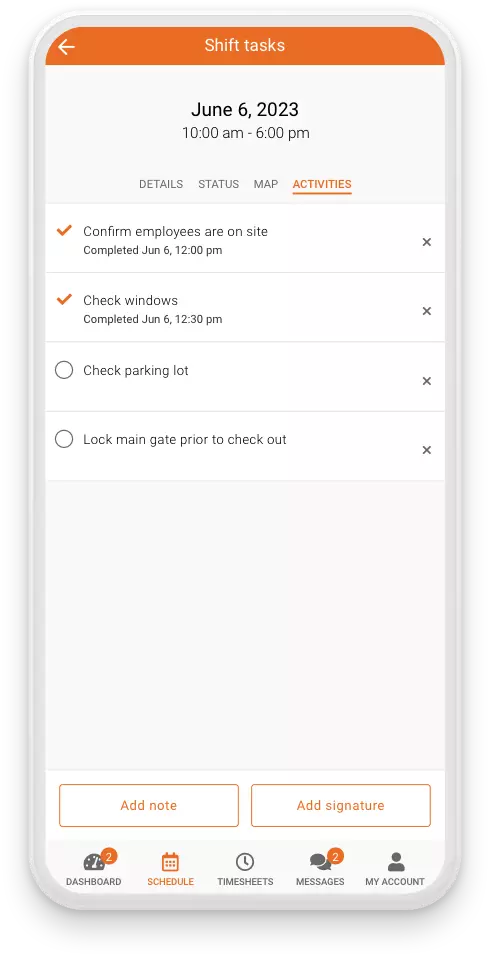In 2022, there were 14.6 million temporary and contract workers in the United States – which has been trending upwards since a drop-off in 2020.
Contract workers, shift workers, part-time staff, full-time employees… it can be difficult to have practices in place to manage all your different types of workers. In each instance, there might be a different employer employee relationship. However, ensuring you have good workforce management and scheduling strategies in place can be the difference between a good work environment and not.
What is a contract worker? 
Contract workers are also known as independent contractors or freelancers. Companies hire contract employees for a specific project or a certain timeframe for a set fee. A contract worker may sometimes work for a couple of other companies simultaneously.
Set terms are laid out in a contract created by the company that hired the contractor. It includes their responsibilities, payment, confidentiality agreements and terms of employment.
What is the difference between an internal employee and a contract worker?
- Employee Benefits: Internal employees are entitled to company benefits like health insurance. For contract workers, most companies won’t provide benefits, so they may need to look into private insurance plans.
- Employee Schedule: As well as that, for internal employees, your hours and time spent working are usually set by your company, whereas contractors have more freedom. They set their own hours and come to an agreement with the client company on what their schedule will be.
- Payroll and Billing: In most cases, internal workers get paid following a fixed schedule, either bi-weekly or monthly. Depending on your role, this can be the same each pay period or fluctuate depending on the hours worked. In contrast, many contract workers have an hourly rate, so pay will vary month to month. If the contract worker is working on a short-term basis with the company, they may receive the payment at the end of the contract.
- Time off: Internal employees are entitled to a set amount of paid time off during the yearly period. Whereas contract workers usually don’t receive paid time off.
- Employment Taxes: One of the main differences between full time employees and contract workers is the tax paid to the IRS (internal revenue service). When it comes to standard employees, the employer witholds federal income taxes, and often even contribute to Social Security and Medicare tax. For contractors however, the responsibility to pay income taxes and social security taxes lies with the contractor!
Benefits of being a contract worker
Contract workers reap a lot of benefits.
- Work-life balance: A great perk of being a contract worker is maintaining a good work-life balance. As contract workers generally get to set their own schedule, they can work the hours that suit them and their lifestyle.
- Make more income: When your skills are in demand, you can be working for multiple companies at once. You set your own pay rate and also get paid by the hour so it provides the ability to earn more money than a salary-based job.
- Being your own boss: Lots of people dream about being their own boss right? Being a contract worker comes with plenty of independence and job security as you are working for yourself and not relying on someone else.
Benefits of hiring a contract worker for business owners.
As well as contract workers reaping the above benefits; companies can also get in on the action. Hiring contract workers has a lot of perks. It is definitely a route to consider to fill your skill gaps.
- Simplified hiring process: If your contract worker is with a recruitment agency, they are usually responsible for the hiring process. This means that all the time you usually spend on finding candidates, screening and interviewing them, you don’t have to worry about. The recruitment agency is also involved in negotiations like salary etc.
- Fill skill gaps: Contract workers are usually specialists in the skills your current internal employees are missing. If you have a big project, you can hire a contract worker for a set time period and avail of the skills needed. Once the project is over you are not committed to keeping them on full-time.
- Save costs: Another great thing about hiring contract workers is that it is cheaper than hiring a full-time internal employee. You will save money on benefits, paid time off and vacation. As soon as your project is over, you won’t incur any more costs, and you are only paying for the skills for as long as you need them.
How do you manage a contract worker?
Employee Onboarding: 
Whether it’s an internal new hire or a contract worker, employee onboarding and training is an important part of the hiring process. Ensure your contract workers are introduced to other members of the team and feel integrated with other workers. They should be made aware of the office policies and who they will be working closely with during their time with the business.
Communication:
Ensure your contract worker is crystal clear about what they’re there to do. They should be made aware of the responsibilities and the expectations of their role as soon as they start. Maintain effective communication between you and your contract worker just as you would any other employee! This can look like regular check-ins with their manager and team to keep them aligned to the task at hand.
Foster good relationships between internal employees and contractors:
Keep contractors in the loop and encourage good relationships between other employees and management. Although contract workers are usually there on a short-term basis it doesn’t mean you may not want to hire them again in the future for another project. This will make things much easier for you as they already know the company and will fit in well.
Dan Pink, the author of Free Agent Nation, maintains that although the relationship between contractors and managers are “less hierarchical, and doesn’t come with the same expectations”. It is still important to actively manage them to ensure they’ll want to work with you again.
How do you schedule a contract worker?
Scheduling your contract workers is a lot different than scheduling your internal employees. Here are some tips on how to schedule contract workers:
Use time tracking software:
This ensures the contractor is accurately tracking their hours and there is transparency on time spent working. Consider using a time tracking software so you are only getting billed for exactly the amount of hours being worked by the contractor.
With Celayix, you can also track the tasks being done by creating task lists that the worker must complete. Our mobile app provides flexibility for those working remotely or on-site. Using our geofencing feature, you can ensure they are checking in correctly at the right location. This means workers can only check-in when they are within a certain boundary of the worksite.
Another perk of using software like Celayix is that it integrates easily with billing and payroll. It will streamline the process of manually calculating how much you owe the contractor and automatically do it all for you.
Flexibility:
Give your contract workers flexibility and allow them to create their own schedules where possible. One of the main perks of being a contract worker is that you can choose your own hours. Your contract worker may be working from a different time zone, so you will need to be flexible in order for it to work. Communicate your needs and expectations clearly with them and come up with a schedule that suits both parties.
Communicate schedule changes:
You need to communicate as soon as possible if there are last-minute schedule changes that need to happen or your project needs to be extended. Contractors may be working for a few companies at once. So if you need them for longer than you originally planned ensure this is brought up instantly. This will give them time to rearrange their schedule and fit your new requirements in.
Contract workers come with lots of benefits to your company and workforce, whether you’re a small business or a large corporation. When you manage and schedule them effectively, they will be more likely to rejoin your team when needed. Foster these relationships and it will benefit you for times to come!










